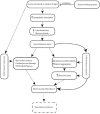Takotsubo Syndrome: Clinical Manifestations, Etiology and Pathogenesis
- PMID: 31995013
- PMCID: PMC8226199
- DOI: 10.2174/1573403X16666200129114330
Takotsubo Syndrome: Clinical Manifestations, Etiology and Pathogenesis
Abstract
The purpose of the review is the analysis of clinical and experimental data on the etiology and pathogenesis of takotsubo syndrome (TS). TS is characterized by contractile dysfunction, which usually affects the apical region of the heart without obstruction of coronary artery, moderate increase in myocardial necrosis markers, prolonged QTc interval (in 50% of patients), sometimes elevation of ST segment (in 19% of patients), increase N-Terminal Pro-B-Type Natriuretic Peptide level, microvascular dysfunction, sometimes spasm of the epicardial coronary arteries (in 10% of patients), myocardial edema, and life-threatening ventricular arrhythmias (in 11% of patients). Stress cardiomyopathy is a rare disease, it is observed in 0.6 - 2.5% of patients with acute coronary syndrome. The occurrence of takotsubo syndrome is 9 times higher in women, who are aged 60-70 years old, than in men. The hospital mortality among patients with TS corresponds to 3.5% - 12%. Physical or emotional stress do not precede disease in all patients with TS. Most of patients with TS have neurological or mental illnesses. The level of catecholamines is increased in patients with TS, therefore, the occurrence of TS is associated with excessive activation of the adrenergic system. The negative inotropic effect of catecholamines is associated with the activation of β2 adrenergic receptors. An important role of the adrenergic system in the pathogenesis of TS is confirmed by studies which were performed using 125I-metaiodobenzylguanidine (125I -MIBG). TS causes edema and inflammation of the myocardium. The inflammatory response in TS is systemic. TS causes impaired coronary microcirculation and reduces coronary reserve. There is a reason to believe that an increase in blood viscosity may play an important role in the pathogenesis of microcirculatory dysfunction in patients with TS. Epicardial coronary artery spasm is not obligatory for the occurrence of TS. Cortisol, endothelin-1 and microRNAs are challengers for the role of TS triggers. A decrease in estrogen levels is a factor contributing to the onset of TS. The central nervous system appears to play an important role in the pathogenesis of TS.
Keywords: Etiology; endothelin-1; microRNAs.; pathogenesis; stress cardiomyopathy; takotsubo syndrome.
Copyright© Bentham Science Publishers; For any queries, please email at epub@benthamscience.net.
Figures
Similar articles
-
Coexistence of acute takotsubo syndrome and acute coronary syndrome.Catheter Cardiovasc Interv. 2020 Oct 1;96(4):825-829. doi: 10.1002/ccd.28595. Epub 2019 Nov 6. Catheter Cardiovasc Interv. 2020. PMID: 31696663
-
Pathophysiology of Takotsubo Syndrome.Circulation. 2017 Jun 13;135(24):2426-2441. doi: 10.1161/CIRCULATIONAHA.116.027121. Circulation. 2017. PMID: 28606950 Review.
-
The Sympathetic Nervous System in the Pathogenesis of Takotsubo Syndrome.Heart Fail Clin. 2016 Oct;12(4):485-98. doi: 10.1016/j.hfc.2016.06.012. Heart Fail Clin. 2016. PMID: 27638019 Review.
-
[Clinical Manifestation of Stressful Cardiomyopathy (Takotsubo Syndrome) and the Problem of Differential Diagnosis with Acute Myocardial Infarction].Kardiologiia. 2020 Dec 15;60(11):777. doi: 10.18087/cardio.2020.11.n777. Kardiologiia. 2020. PMID: 33487160 Russian.
-
Coronary artery myointimal dysplasia in patients with pheochromocytoma-possible causal relationship: pathophysiology and clinical implication with reference to Takotsubo cardiomyopathy and spontaneous coronary dissection.Cardiovasc Pathol. 2018 Nov-Dec;37:45-53. doi: 10.1016/j.carpath.2018.10.001. Epub 2018 Oct 11. Cardiovasc Pathol. 2018. PMID: 30342321
Cited by
-
Takotsubo Syndrome and Coronary Artery Disease: Which Came First-The Chicken or the Egg?J Cardiovasc Dev Dis. 2024 Jan 26;11(2):39. doi: 10.3390/jcdd11020039. J Cardiovasc Dev Dis. 2024. PMID: 38392253 Free PMC article. Review.
-
SARS-CoV-2-associated Takotsubo is not necessarily triggered by the infection.Int J Cardiol Heart Vasc. 2020 Jul 25;30:100606. doi: 10.1016/j.ijcha.2020.100606. eCollection 2020 Oct. Int J Cardiol Heart Vasc. 2020. PMID: 32766418 Free PMC article. No abstract available.
-
Features of α2-Adrenergic Regulation of Isolated Rat Heart after Hypokinesia.Bull Exp Biol Med. 2023 Dec;176(2):156-159. doi: 10.1007/s10517-024-05986-4. Epub 2024 Jan 8. Bull Exp Biol Med. 2023. PMID: 38189872
-
Ferroptosis, a Regulated Form of Cell Death, as a Target for the Development of Novel Drugs Preventing Ischemia/Reperfusion of Cardiac Injury, Cardiomyopathy and Stress-Induced Cardiac Injury.Int J Mol Sci. 2024 Jan 11;25(2):897. doi: 10.3390/ijms25020897. Int J Mol Sci. 2024. PMID: 38255971 Free PMC article. Review.
-
Broken Heart Syndrome: Evolving Molecular Mechanisms and Principles of Management.J Clin Med. 2022 Dec 24;12(1):125. doi: 10.3390/jcm12010125. J Clin Med. 2022. PMID: 36614928 Free PMC article. Review.
References
MeSH terms
LinkOut - more resources
Full Text Sources
Other Literature Sources



